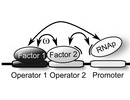Kinetics of Combinatorial Transcription Regulation
Much of the complexity observed in gene regulation originates from cooperative protein-DNA binding. While studies of the target search of proteins for their specific binding sites on the DNA have revealed design principles for the quantitative characteristics of protein-DNA interactions, no such principles are known for the cooperative interactions between DNA-binding proteins. We consider a simple theoretical model for two interacting transcription factor (TF) species, searching for and binding to two adjacent target sites hidden in the genomic background. We study the kinetic competition of a dimer search pathway and a monomer search pathway, as well as the steady-state regulation function mediated by the two TFs over a broad range of TF-TF interaction strengths. Using a transcriptional AND-logic as exemplary functional context, we identify the functionally desirable regime for the interaction. We find that both weak and very strong TF-TF interactions are favorable, albeit with different characteristics. However, there is also an unfavorable regime of intermediate interactions where the genetic response is prohibitively slow.


